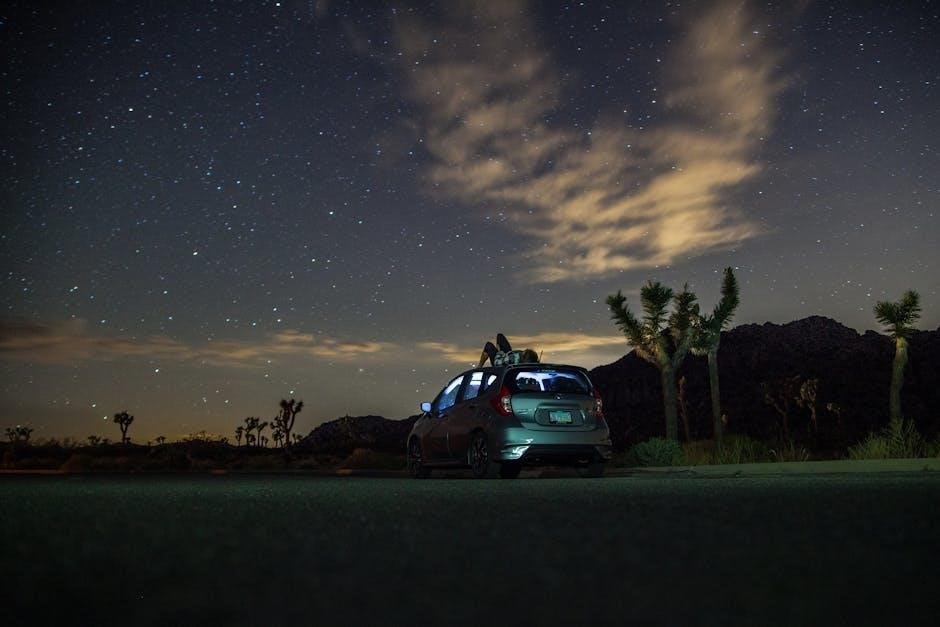Can a Manual Car Have Remote Start?
A manual car can have a remote start system installed, but it requires specialized safety features like clutch bypass and neutral verification to ensure safe operation․
Remote start systems have become increasingly popular, offering convenience and comfort, especially in cold climates․ While traditionally associated with automatic transmissions, manual cars can also be equipped with remote starters․ However, this requires specialized systems to address unique challenges․ Manual transmissions lack the automatic “park” feature, so additional safety measures are necessary to prevent accidental movement․ These systems typically involve clutch bypass mechanisms and neutral verification to ensure the car remains stationary when started remotely․ Despite these complexities, advancements in technology have made it possible for manual car owners to enjoy the benefits of remote starting․ This article explores the feasibility, requirements, and considerations for installing a remote start in a manual transmission vehicle․

Is It Possible to Install a Remote Start in a Manual Transmission Car?
Yes, it is possible to install a remote start in a manual transmission car, but it requires specialized systems to bypass the clutch interlock and ensure safety features like neutral verification are in place to prevent accidental movement․
Overview of Remote Start Systems for Manual Cars
Remote start systems for manual cars function by bypassing the clutch interlock, allowing the engine to start without the clutch pedal being pressed․ These systems often include a module that interfaces with the vehicle’s wiring to control the starter motor and ensure safe operation․ Neutral verification is a critical feature, ensuring the car is in neutral before remote starting to prevent unintended movement․ Additionally, many systems require the parking brake to be engaged for added safety․ While compatibility varies, modern remote starters are designed to work with manual transmissions, though specialized installation may be necessary․ Environmental and legal considerations, such as anti-idling laws, should also be taken into account․ Always prioritize safety and proper installation to avoid potential risks․
Specialized Requirements for Manual Transmissions
Manual transmission cars require specific components for remote start systems to function safely and effectively․ A clutch bypass module is essential to simulate the clutch pedal’s signal, allowing the engine to start without manual input․ Neutral verification ensures the vehicle is in neutral gear before remote starting, preventing accidental movement․ Additionally, engagement of the parking brake is often mandatory to add an extra layer of safety․ These features work together to mitigate risks associated with remote starting a manual car, such as unintended rolling or theft․ Proper installation by a professional is crucial to ensure all safety protocols are met and the system operates reliably․ These specialized requirements address the unique challenges of manual transmissions, ensuring safe and convenient remote starting capabilities․

Legal Considerations and Restrictions
Some states prohibit remote starters in manual cars due to safety risks, while others impose strict regulations․ Environmental laws also restrict unnecessary idling, affecting remote start usage․
States That Prohibit Remote Starters in Manual Cars
Certain states, including New York and Minnesota, have outright banned the use of remote starters in manual transmission vehicles due to safety concerns․ These states enforce strict regulations to prevent accidents caused by unintended vehicle movement when the engine is started remotely․ In Massachusetts and Oregon, while not entirely prohibited, specific conditions must be met, such as ensuring the vehicle is in neutral or parked․ California and Colorado also have anti-idling laws that indirectly affect remote start usage․ These laws aim to reduce emissions and curb unnecessary engine idling, further complicating the legal landscape for remote starters in manual cars․ Owners must consult local authorities to ensure compliance with these regulations․
Specific Laws and Regulations in Different States
In New York, remote starters in manual cars are prohibited to prevent unexpected vehicle movement․ Minnesota follows suit, banning their use for similar safety reasons․ Massachusetts allows remote starts only if the car is in neutral or parked, while Oregon has no specific bans but enforces strict anti-idling laws․ California and Colorado also regulate remote starters through anti-idling laws, limiting engine runtime to reduce emissions․ These state-specific rules highlight the varying legal approaches to balancing convenience and safety․ Car owners must adhere to these regulations to avoid legal consequences, ensuring their remote start systems comply with local laws and environmental standards․ Compliance varies widely, so checking state-specific guidelines is essential before installation․

Safety Concerns and Risks
Manual cars with remote starts risk accidental movement if not properly secured in neutral or with the parking brake, posing accident and injury hazards․
Potential Dangers of Remote Starters in Manual Cars
Remote starters in manual cars pose risks like unexpected movement if the vehicle isn’t properly secured in neutral or with the parking brake engaged․ This can lead to accidents, injuries, or property damage, especially on inclines․ Additionally, carbon monoxide poisoning is a hazard if the car is left running in enclosed spaces․ Improper installation can also cause the car to start in gear, increasing safety risks․ Furthermore, environmental concerns arise from increased emissions due to extended idling․ To mitigate these dangers, ensure the car is in neutral, engage the parking brake, and avoid starting the engine in enclosed areas․ Proper installation and adherence to safety protocols are crucial to minimize risks․
To prevent accidents with remote starters in manual cars, ensure the vehicle is in neutral and the parking brake is engaged before starting the engine remotely; Always park on a level surface to prevent rolling․ Avoid starting the car in enclosed spaces to reduce carbon monoxide risks․ Install a carbon monoxide detector in the area where the car is parked․ Use reservation mode, which confirms the car’s safety before starting, and ensure the system includes safety features like automatic shut-off if movement is detected․ Professional installation is crucial to avoid improper setup․ Follow all manufacturer guidelines and local laws to ensure safe operation․ Regular maintenance of the remote start system can also help prevent potential issues․ Adhering to these measures significantly reduces the risk of accidents and ensures safe use of the remote start feature․ Installing a remote start in a manual car requires bypassing the clutch interlock and ensuring the car is in neutral with the parking brake engaged for safe operation․ The installation of a remote start in a manual car necessitates a clutch bypass mechanism to simulate the clutch pedal’s engagement, enabling the engine to start without manual input․ Additionally, a neutral verification system ensures the vehicle is in neutral gear before remote starting, preventing accidental movement․ These systems are crucial for safety, as they mitigate the risk of the car rolling or moving unexpectedly․ The clutch bypass typically involves wiring that mimics the signal produced when the clutch pedal is pressed, while the neutral verification system monitors the gear position․ Together, these technologies allow remote starting in manual transmissions while maintaining safety standards․ Proper installation by a professional is essential to ensure reliability and avoid potential hazards․ Engaging the parking brake is a critical safety measure when using a remote start system in a manual car․ It ensures the vehicle remains stationary, preventing unintended movement even if the transmission shifts out of neutral․ Modern remote start systems often require the parking brake to be engaged as a failsafe, adding an extra layer of security․ This practice minimizes the risk of accidents or property damage caused by the car rolling while unattended․ By integrating parking brake engagement, remote start systems enhance overall safety, complementing other features like neutral verification․ This dual safety approach ensures that the vehicle cannot move unless the driver is present and in control, addressing potential risks associated with remote starting in manual transmissions․ Remote starters in manual cars can increase emissions and fuel consumption, contributing to air pollution․ Unnecessary idling raises environmental concerns, prompting stricter anti-idling laws in many regions․ Remote starters in manual cars can increase emissions and fuel consumption due to prolonged engine idling․ This unnecessary idling produces excess emissions, contributing to air pollution and environmental degradation․ Improper installation may lead to higher fuel use, exacerbating emissions․ Frequent remote starting can also reduce overall fuel efficiency, impacting both the environment and operational costs․ Ensuring proper installation and adherence to anti-idling laws is crucial to mitigate these effects․ Anti-idling laws restrict how long a vehicle can remain running without moving, impacting remote start use in manual cars․ These laws aim to reduce emissions and conserve fuel․ States like California, Colorado, and New York enforce strict idling limits, typically 3-5 minutes, with exemptions for emergency vehicles․ Using remote start in manual cars may violate these laws if the engine runs excessively․ Owners must check local regulations before installing remote starters to avoid fines․ Proper installation and adherence to these laws are essential to ensure compliance and environmental responsibility․ Not all manual cars are compatible with remote starters, as many manufacturers do not support this feature․ Compatibility depends on the vehicle’s make and model, requiring specific systems designed for manual transmissions․ Always consult the manufacturer’s guidelines and warranty terms before installation to ensure compliance and avoid potential issues․ Not all manual cars are compatible with remote starters, as compatibility varies by make and model․ Some manufacturers explicitly prohibit remote starters in manual vehicles due to safety concerns․ Modern cars with advanced security systems often require specialized bypass modules․ Additionally, vehicles with clutch interlock systems need a specific bypass to enable remote starting․ Compatibility also depends on the car’s wiring and transmission type․ It’s crucial to consult the vehicle’s service manual or contact the manufacturer to determine if a remote starter can be safely installed․ Professional installation is recommended to ensure proper functionality and avoid potential risks․ Compatibility issues highlight the need for careful consideration before proceeding․ Installing a remote start in a manual car may void the manufacturer’s warranty, as many manufacturers do not endorse such modifications․ Some manufacturers, like Honda, explicitly recommend against aftermarket remote starters for manual transmissions due to safety and operational concerns․ It’s essential to review the vehicle’s service manual or consult with the manufacturer to understand their stance on remote starters․ Additionally, certain manufacturers only permit remote start systems installed through authorized dealerships to maintain warranty coverage․ Always verify compatibility and ensure the installation adheres to the manufacturer’s guidelines to avoid potential issues․ Professional installation is highly recommended to preserve both safety and warranty integrity․ Many car owners wonder if manual cars can have remote start systems․ Yes, they can, but specialized systems are required to ensure safety․ These systems bypass the clutch interlock and include features like neutral verification and parking brake engagement․ Legal restrictions vary by state, so checking local laws is essential․ Environmental impact is another consideration, as remote starters can increase emissions․ Professional installation is recommended to avoid potential risks like accidental movement․ Additionally, not all manual cars are compatible with remote starters, so consulting the vehicle manufacturer is crucial․ Overall, while feasible, installing a remote start in a manual car requires careful planning and adherence to safety guidelines to prevent hazards and ensure proper functionality․Preventive Measures to Avoid Accidents

Installation Process and Requirements
Clutch Bypass and Neutral Verification Systems
Role of Parking Brake Engagement in Safety

Environmental Impact
Increased Emissions and Fuel Consumption
Anti-Idling Laws and Their Implications

Manufacturer Policies and Compatibility
Are All Manual Cars Compatible with Remote Starters?
Warranty and Manufacturer Recommendations
Frequently Asked Questions